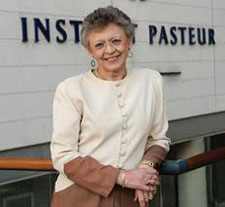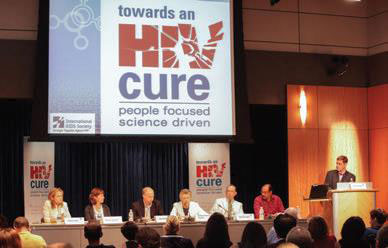Françoise Barré-Sinoussi, Ph.D., is a renowned virologist and director of the Regulation of Retroviral Infections Unit at the Institut Pasteur in Paris, France. Dr. Barré-Sinoussi has been at the forefront of AIDS research since the beginning of the epidemic and in 2008 she was awarded the Nobel Prize in Physiology or Medicine, with Luc Montagnier, for their discovery of HIV in 1983. In July 2012 she was named president of the International AIDS Society.

Photo: Laurent Perrigault (Froggies) |
TREAT Asia Report: The International AIDS Society launched its Global Scientific Strategy, “Towards an HIV Cure,” last July. What do you think we can do to accelerate the pace of cure research? Is it just a matter of increasing resources?
Dr. Françoise Barré-Sinoussi: No, in my opinion that’s not sufficient. Of course we need more funding but we also need to work better together. We need to improve coordination between the different HIV cure programs. We need to have more ongoing multidisciplinary research to better integrate basic science with clinical research and social science.
TA Report: Do you think these things are beginning to happen now? For example, the NIH has its cure collaboratory and amfAR has its ARCHE program (amfAR Research Consortium on HIV Eradication).
Dr. Barré-Sinoussi: I think it’s a real start, with the different consortiums that have been launched since we started the international working group on cure. But we need more interaction between scientists and to integrate all the components that are required. We need to have more collaboration with the private sector as well. And collaboration between pharmaceutical companies is a complex issue, as you know.
We already started a working group with representatives of different pharmaceuticals. Recent data indicate that reactivating latently infected cells alone will not be sufficient. We may need to stimulate the immune system as well, in order to eliminate the cells that are reactivated. That means only a combination of different approaches will effectively cure HIV. It is thus important to be engaged very early in a dialogue with pharma to envisage how to develop that kind of combination.
TA Report: What do think are the most promising cure-focused research projects under way right now?
Dr. Barré-Sinoussi:It’s difficult to say, because we don’t know the results! Of course, there are the HDAC inhibitors, or a similar drug that reactivates latently infected cells, but, as I said, that will not be sufficient and we certainly need other strategies. It’s too early to say because we need to test drugs—or some other strategy—separately and then to combine the best strategies. And that will take quite a long time.
TA Report: Can you tell us a little bit about your own current research?
Dr. Barré-Sinoussi: My lab is working on HIV pathogenesis and how to control HIV disease progression. We are involved in a cohort in France called “the VISCONTI patients.” These patients were treated very early after infection, and after three years they stopped their treatment and they are now able to control their viral load by themselves. They have undetectable viral loads without any treatment and they’re doing perfectly well. We are trying to understand the mechanisms behind this. We know they are different from elite controllers. They don’t have the strong CD8 [immune] response or HLA B57 or B27 [genetic profiles associated with ability to control the virus] related to control in the elite controllers. Interestingly, these patients have a very low level of [HIV] reservoir in relation to their ability to control the virus. We are now trying to better characterize the mechanisms that led to this control. In addition, these data reinforce the idea that treating very early is certainly a good solution—but a challenging one on a large scale.
We are also working on African green monkeys that are natural hosts of SIV [Simian Immunodeficiency Virus]. We are trying to understand how they can control the development of disease and the relationship with a low level of [immune] activation, which is a characteristic of these primates. A group in my team is also involved in studying innate immunity and the interaction between NK [natural killer] cells and dendritic cells, looking at the impact of these interactions on the control of HIV infection in the blood and at the mucosal level. These are the main topics.
TA Report: Are you optimistic about the future of cure research?
Dr. Barré-Sinoussi: Yes, I’m optimistic because I can see things are moving forward…and I assume in the coming year there will be more collaboration between the different groups. Of course we still have a long, long way to go.

Photo: Institut Pasteur
Dr. Barré-Sinoussi is based at the renowned Institut Pasteur in Paris.
|
TA Report: What about the prospects for vaccine development?
Dr. Barré-Sinoussi: I don’t think we should pit vaccine research against cure research because we need to have interaction between researchers working on HIV cure and researchers working on vaccines. Antibodies are traditionally viewed in the context of vaccines, but they may also be important for cure research. So I think new developments are coming in the field of vaccines.
TA Report: You started going to Asia in the late 1980s and have collaborated on projects in the region since then. Are there challenges that are specific to Asia in confronting HIV, both in the research arena and at the community level?
Dr. Barré-Sinoussi: Indeed, the French National Agency for Research on AIDS and Viral Hepatitis (ANRS) has quite a long history of collaboration with Southeast Asia. If you consider a country I know quite well, Vietnam, one characteristic is HIV infection in drug users. We are discussing a collaboration with NIDA [U.S. National Institute on Drug Abuse] to develop studies of drug users in Vietnam. Additionally we have already done some work on co-infection with TB and HIV both in Vietnam and Cambodia. We were involved in the CAMELIA trial, sponsored by the ANRS and the NIH, that clearly showed that starting HAART earlier after TB treatment improves the survival of people with HIV/TB coinfection. The trial is finished but there are still other projects under way in Cambodia and Vietnam on how to improve the treatment of co-infection with TB and HIV. Another challenge that we are seeing in the region is co-infection with HIV and HCV.
amfAR and TREAT Asia are of course very much involved in the region, and I think we can improve collaboration between amfAR-TREAT Asia and other organizations that operate in the region.
TA Report: You’ve been involved with the International AIDS Society for some time now and you became its president last year. What inspired you to get more involved in the IAS and what do you hope to accomplish as president?
Dr. Barré-Sinoussi: First of all, I wanted to try and stimulate research on an HIV cure. One role of the IAS is to be an advocate for science and one of our priorities is to promote and accelerate research on a cure, and we will continue with that. We have several working groups on social science, cost-effectiveness, ethics and, as I mentioned previously, one industry collaborative group. We are trying to better coordinate cure research at the international level.
The IAS also has other priority areas including key affected populations, treatment as prevention, social and political research, human rights, and effectiveness and efficiency. Our objective in each of these areas is to promote and advocate for the implementation of scientific evidence-based responses.
As I mentioned in Washington, we also want to promote women in science and we’re looking at the enrollment of women in clinical trials. The proportion of women enrolled in clinical trials is much lower than men. Earlier I mentioned injecting drug users, but we also have to consider men who have sex with men and all the key affected populations. This certainly has specific implications for Asia.

Dr. Barré-Sinoussi co-chaired a symposium titled “Towards an HIV Cure” preceding the 2012 International AIDS Conference. Among the panelists (second from left) was Dr. Rowena Johnston, vice president and director of research at amfAR.
TA Report: Infection rates among MSM are on the rise in many parts of the world. What can we do to turn that around?
Dr. Barré-Sinoussi: It’s a complex issue related to many practical, but mostly political and societal challenges that are truly impeding access to health services. Many countries still have repressive laws regarding men having sex with other men. We really need to advocate for the abolition of those laws that flout human rights, and we really need to start educating the new generation as well.
TA Report: You have been at the forefront of AIDS research for many years now. What is your current perspective on whether we can really get this epidemic under control?
Dr. Barré-Sinoussi: If we can improve access [to treatment]—and universal access to antiretroviral therapy is still a long way off—we know that we can slow down the epidemic everywhere in the world. We know that we can be successful in reaching an AIDS-free generation because we have the tools for that, but on the other hand we know that for economic reasons it would be very difficult to accomplish.
We have already seen some progress in Africa and other parts of the world regarding improvements in public health infrastructure. We know that there are not enough health professionals so we have to help communities improve access to HIV testing. In some countries, rapid testing is already available through communities, and then people can be linked with health services. But we have to continue the research because, of course, if we can develop new therapeutic agents and a vaccine, these will be additional tools for prevention and treatment. So we need to have both action and research.